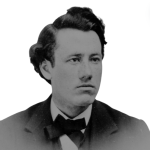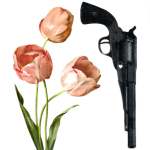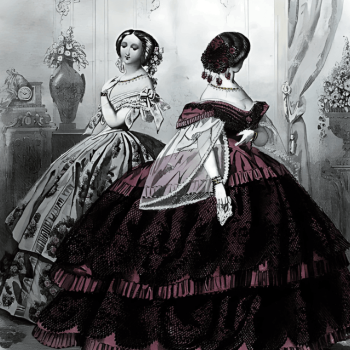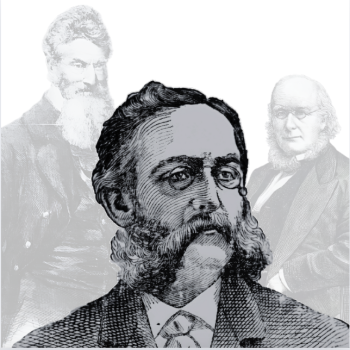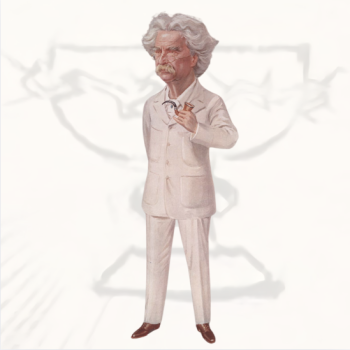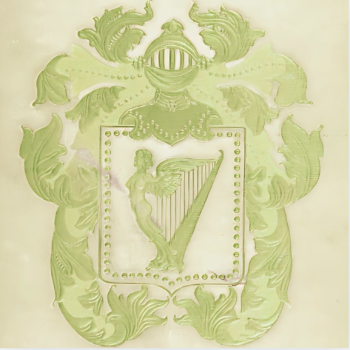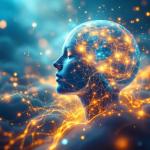THE ENCOUNTER WITH THE STRANGER
August 22, 1875.
Olcott used to go to The Sun and tell the reporters how one of the Eddy brothers had floated out of a window for a distance of three miles, landing safely on a mountain.
“Levitation is possible,” Olcott said earnestly, “for anyone having confidence in the fidelity of the spirit guardians.”
Edward Page Mitchell and Frank Church of were skeptical.
“Let’s go,” said Church. “We will go with you to the top of the tall tower of the Tribune building, and levitate one after the other down into Printing House Square, you leading. I promise on honor to follow when I have seen you reach the pavement without fracture.”[1]
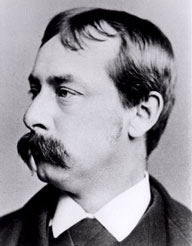
Francis “Frank” Pharcellus Church. (Source: Wiki)
That evening, a stranger entered Olcott’s chambers at the Lotos Club by appointment. The fair-skinned Asian (whom Olcott assumed was a Hindu) met Olcott earlier that day with a desire to conduct a psychical test. They opened the folding doors which partitioned the sitting room from the bedroom, and took a seat on chairs which faced the wide doorway.
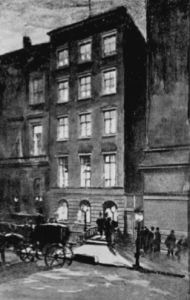
Lotos Club, 2 Irving Place.[2]
Suddenly the furniture disappeared from view, and the bedroom seemed transformed into a cube of empty space. There appeared, alternately, visions of water, cloudy skies, subterranean caves, and an active volcano; archetypes of the four elements, each teeming with creatures, shapes, and faces of which Olcott caught transient glimpses. Some of the beings were beautiful, some were malignant; some were fierce, and some terrible. Some would gently float into view like bubbles on a smooth stream, while others darted across the scene and disappear or play together in flame or flood. Then a horrid, misshapen, monster appeared. It glared at Olcott before plunging forward, as though it wished to seize him. It faded away when it reached the wall of the cube where the two rooms joined. It frayed Olcott’s nerves, but after his experiences at the Eddy farm, he managed not to weaken. The stranger then declared himself satisfied with the result of psychical test.
“Perhaps we might meet again,” he said upon leaving.[3]
The following day, Olcott wrote a letter, “The Immortal Life,” to The New York Tribune, following along the occult lines which Blavatsky articulated in “A Few Questions to ‘Hiraf.’” Olcott writes:
Suppose I should tell you that, in a most unexpected way and at a most fortuitous time, I had come into contact with living persons who could do, and had in my presence done the very marvels that Paracelsus, Albertus and Apollonius are credited with; that all these seeming miracles of the cycle are no miracles at all, but natural manifestations of absolute natural law; that man has dominion over the powers of nature by right of his immortal soul’s divine parentage; that the true “spirits” which produce nine-tenths of the genuine “manifestations” are not the spirits of men or women from earth, but something quite different, and something that does not inhabit our future world, nor stroll with us among the asphodels; that the wise, the pure, the just, the heroic souls who have passed on before us into the Silent Land, cannot and do not come back to spout sapphics through scrub-women, nor swing through the air on a spiritual trapeze at the bidding of poverty-stricken Mediums, for the delectation of the gaping crowd.[4]
Meanwhile the search continued for mediums to send to St. Petersburg for Aksakov’s psychical tests. One promising candidate was Anna Kimball, the niece of the early Mormon leader, Heber C. Kimball. She was quite popular in the Spiritualist movement, and campaigned in Victoria Woodhull’s Equal Rights Party in 1872.[5] She received messages from spirits in séances she called “Star Circles.”[6] What made her manifestations unique was the mythos. Kimball claimed that some of the spirits were from beings that once inhabited the doomed planet of Sideros.[7] Kimballs spirit guides, however, directed her to leave for England in late 1875.
Olcott then learned of Belle Youngs, a largely-built woman, with obstreperous manners, who lived in Manhattan at Twenty-seventh Street. Her chief phenomenon was the causing of the spirits to raise a full-sized, heavy pianoforte from off the floor, and make it sway in time to her playing upon the instrument.[8] Weeks earlier, her second husband, Theophilus Youngs, had vanished mysteriously, and was presumed dead; she was, however, a strong woman, both physically and psychically, Youngs served at the front as a nurse, “from the first tap of the drum until the last shot was fired,” and bore several bullet wounds in her body. A less gruesome souvenir of the war was the gold medal she wore around her neck. It was an honor presented to her by President Lincoln himself for her devotion to sick and wounded soldiers.[9]
Lincoln and his wife, Mary Todd, was an old family friend of Youngs, frequently attending séances hosted by her father, Cranston Laurie, was a well-known Spiritualist in Washington, D.C. Youngs’s first husband, James McDowell Miller, served with Lincoln in the Black Hawk War. Very often, when Lincoln was wearied, he would “get his brain straightened,” with visits to their home on First Street in Georgetown, just below Forest Hall Prison. At President Lincoln’s request, Youngs herself would hold séances in the White House.[10] It was intimated in Spiritualist circles that the issuing of the Proclamation of Emancipation was due to the influence of spirits. Youngs confessed that she never had a conversation about the topic when she was with Lincoln, however, she would add: “I may have said something about it in a trance, but if I did, I had no recollection of it when I came out of it.”[11]
Olcott paid a visit to Blavatsky, who now lived at 46 Irving Place, and asked if she would accompany him to Youngs’s séance and see what she could do. Blavatsky agreed. So Olcott placed into his pocket three things he intended to use as new tests of Youngs’s mediumship, a raw egg and two English walnuts.
They arrived Youngs’s parlors on the evening of August 26, 1875, where fifteen well-known people had gathered, several of whom being reporters. At one end of the room there was a large, deep, seven-and-a-half octave piano, which appeared to weigh at least a thousand pounds.
The performances began when Youngs rested her hands lightly on top of the music rack, and asked the spirits a question. The invisible powers responded by lifting the piano; three times for “yes” and once for “no.”
“Now, then, spirits,” Youngs would say, “don’t be lazy; hurry up; what are you about?” Her bullying tone towards her “guides in Spirit Land” was a humorous contrast with the honeyed accents commonly used by most mediums towards the invisibles. “Move the piano, or do this or that. Come, we are all waiting!”
Youngs then sat down and played various songs. When she did, the piano began to tilt on the two outer legs—those farthest from her— and, along with the other two legs, raised eight inches off the ground in time to the music. She then went to the end of the piano and called forth Olcott, Blavatsky, and several others to make the experiment. Youngs instructed everyone to place their left hand underneath the case. She then went to one end of the piano and, laying a single finger against the underside of the case, lifted the tremendous weight with the greatest ease.
“Mrs. Youngs,” asked Olcott, “may I be permitted to make a single test which will not cause you any injury?”
Youngs agreed.
Olcott then produced the hen’s egg from a box.
“Would you be so kind as to hold this in your hand against the underside of the piano, and then ask the spirits to raise it?”
“In the course of my mediumship, such a test had never been suggested,” said Youngs. “I cannot say that it will be successful, but I will try.”
Youngs took the egg and held it as Olcott requested, and then, rapping upon the case with her other hand, demanded the spirits to see what they could do. The piano instantly rose as before, and was held for a moment suspended in the air.
Youngs then invited the heaviest people in the room to sit upon the piano, of which seven ladies and gentlemen accepted. Youngs then played a march, and the instrument was lifted, with its burden of people, effortlessly into the air.
Olcott then brought out the two English walnuts.
“Spirits,” requested Olcott, “would you kindly crack the shells of these walnuts under the piano legs without crushing the kernels.”
The idea behind this experiment was to discern whether or not some power other than Youngs’s was exerting itself. The spirits were willing, but since the piano rested on rolling castors, the test was abandoned. Olcott then asked to be allowed to hold the egg in his own hand against the under ride of the piano, and have Youngs lay hers beneath and against it. This was done so as to have a clear demonstration that no muscular force was exerted Youngs. The test was agreed to, and immediately carried out. Olcott pressed the egg lightly against the underside of the piano-case at one end, and had Youngs lay the palm of one of her hands against the back of his hand that held the egg.
“Mrs. Youngs,” said Olcott, “please command the piano to rise.”
Only a moment’s pause ensued when, to Olcott’s surprise, one end of the piano did rise without so much pressure on the egg as to break the shell.
The manifestations of the evening were then brought to a close with the lifting of the piano without Youngs’s hand touching it at all.[12]
SOURCES
[1] Mitchell, Edward Page. Memoirs Of An Editor: Fifty Years of American Journalism. Charles Scribner’s Sons. New York, New York (1924): 186-187.
[2] Elderkin, John. A Brief History Of The Lotos Club. Press of MacGowan & Slipper. New York, New York. (1895): Frontispiece.
[3] Olcott, Henry Steel. Old Diary Leaves: Volume I. Theosophical Publishing Society. London, England. (1895): 111-112.
[4] Olcott, Henry Steel. “The Immortal Life.” The New York Tribune. (New York, New York) August 30, 1875.
[5] “The Woodhull Convention.” The New Northwest. (Portland, Oregon) June 7, 1872; Mrs. Anna Kimball, The Mind Reader.” The Salt Lake Herald. (Salt Lake City, Utah) April 18, 1885.
[6] Kimball, Anna. “Leaves From My Life Book.” The Gnostic. Vol. I, No. 1 (July 1885): 18.
[7] Denton, William. “Sideros And Its People As Independently Described By Many Psychometers.” The Religio-Philosophical Journal. Vol. XXIX, No. 12 (November 20, 1880): 2.
[8] Olcott, Henry Steel. “Spiritualism And Theosophy.” The Spiritualist. Vol. XVII, No. 436. (December 31, 1880): 313-317, 322-323.
[9] “A Mystery To Be Solved.” The Richmond Dispatch. (Richmond, Virginia) December 1, 1880.
[10] “Dr. Peebles At Dougherty Hall.” The Medium And Daybreak. Vol. IX, No. 408. (January 25, 1878): 49-51.
[11] “Youngs Again.” The Boston Globe. (Boston, Massachusetts) July 23, 1878.
[12] “A Most Astonishing Test.” The Sun. (New York, New York) August 27, 1875; Olcott, Henry Steel. Old Diary Leaves: Volume I. Theosophical Publishing Society. London, England. (1895): 85, 111-112.


